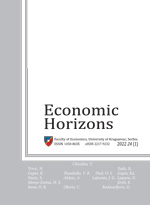
THE JOURNAL IS PUBLISHED
THREE TIMES A YEAR
in April, August and December
Radovan Kovačević
Faculty of Economics, University of Belgrade, Belgrade, The Republic of Serbia
In this paper, the adequacy of foreign exchange reserves in the Republic of Serbia (RS) and the factors that influence their accumulation is analyzed by means of an econometric model. The relevant variables, such as the Gross Domestic Product (GDP), the Real Effective Exchange Rate (REER) and monetary aggregate M2/GDP are included in the analysis. The unit root tests applied in the research led to the conclusion that the timeseries were integrated of the order I(1). The cointegration test revealed that there was one cointegration equation. The regression model was estimated using the quarterly data for the period from 2002q1 to 2020q3. The estimated cointegration coefficients showed that the economic activity approximated in terms of the GDP had a significant influence on foreign exchange reserves accumulation, which is only followed by appreciation pressure on the dinar (approximated by the REER index) and money supply growth (estimated through the monetary aggregate M2/GDP). In addition to conventional factors, the analysis also points out specific factors and their impact on foreign exchange reserve accumulation in RS. The results of the research study show that foreign exchange reserves in RS are greater than the levels suggested by standard optimality criteria. The findings also suggest that it is necessary to take into account the dividends realized by foreign investors, as well as some segments of portfolio investment in assessing the specific indicator of the adequate level of foreign exchange reserves.
Keywords:
JEL Classification:
Since March 2015, the Journal is indexed in DOAJ
Since November 2013, the Journal is indexed in ProQuest – ABI/INFORM
Since October 2013, the Journal is indexed in Cabell’s Directories
Since September 2013, the Journal is indexed in Index Copernicus Journals Master List 2012
Since March 2013, the Journal has been evaluated and accepted for listing in EconLit (American Economic Association Publications)
Since January 2013, the Journal has been included into EBSCO’s databases
Since November 2012, the Journal has been included into Ulrich’s Periodicals Directory
Since March 2015, the Journal is indexed in DOAJ
Since November 2013, the Journal is indexed in ProQuest – ABI/INFORM
Since October 2013, the Journal is indexed in Cabell’s Directories
Since September 2013, the Journal is indexed in Index Copernicus Journals Master List 2012
Since March 2013, the Journal has been evaluated and accepted for listing in EconLit (American Economic Association Publications)
Since January 2013, the Journal has been included into EBSCO’s databases
Since November 2012, the Journal has been included into Ulrich’s Periodicals Directory